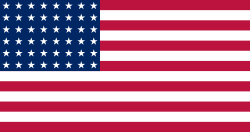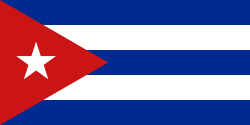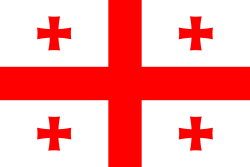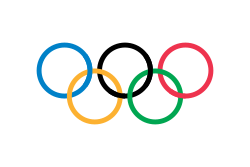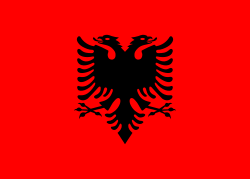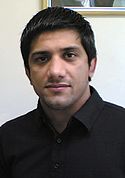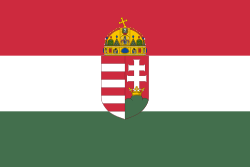Alírezá Dábir
| Alírezá Dábir | |
|---|---|
 | |
| Narození | 16. září 1977 (45 let) Teherán |
| Alma mater | Allameh Tabataba'i University |
| Povolání | zápasník |
| Politická strana | Progress and Justice Population of Islamic Iran |
| Některá data mohou pocházet z datové položky. | |
| Přehled medailí | ||
|---|---|---|
| zlato | LOH 2000 | bantamová váha |
| Mistrovství světa v zápasu ve volném stylu | ||
| zlato | MS 1998 | bantamová váha |
| stříbro | MS 1999 | bantamová váha |
| stříbro | MS 2001 | pérová váha |
| stříbro | MS 2002 | lehká váha |
Alírezá Dábir (persky علیرضا دبیر), (* 16. září 1977 v Teheránu, Írán) je bývalý íránský zápasník volnostylař, olympijský vítěz z roku 2000.
Sportovní kariéra
Volnému stylu se věnoval od 11 let v rodném Teheránu. Členem íránské seniorské reprezentace byl od roku 1996. V roce 1998 získal před domácím publikem titul mistra světa v bantamové váze. V roce 2000 startoval jako jeden z favoritů na olympijských hrách v Sydney. V základní skupině nezávahal a zvládl i vyhrocený semifinálový zápas s Američanem Terry Brandsem. Ve finále porazil Ukrajince Jevhena Buslovyče a získal zlatou olympijskou medaili. Od roku 2003 často laboroval se zraněními. V roce 2004 startoval na olympijských hrách v Athénách s otejpovaným pravým ramenem a nepostoupil ze základní skupiny. Sportovní kariéru ukončil po roce 2005.
Výsledky
| Turnaj | 1998 | 1999 | 2000 | 2001 | 2002 | 2003 | 2004 |
|---|---|---|---|---|---|---|---|
| 21 | 22 | 23 | 24 | 25 | 26 | 27 | |
| bantamová váha | lehká váha | ||||||
| Olympijské hry | 1. | 18. | |||||
| Mistrovství světa | 1. | 2. | 2.[1] | 2. | 35. | ||
Reference
- ↑ startoval v pérové váze
Externí odkazy
 Obrázky, zvuky či videa k tématu Alírezá Dábir na Wikimedia Commons
Obrázky, zvuky či videa k tématu Alírezá Dábir na Wikimedia Commons - Alírezá Dábir v databázi Olympedia (anglicky)
- Výsledky Alírezy Dábira na iat.uni-leipzig.de
Média použitá na této stránce
Olympic Rings without "rims" (gaps between the rings), As used, eg. in the logos of the 2008 and 2016 Olympics. The colour scheme applied here was specified in 2023 guidelines.
Olympic Rings without "rims" (gaps between the rings), As used, eg. in the logos of the 2008 and 2016 Olympics. The colour scheme applied here was specified in 2023 guidelines.
US Flag with 45 stars. In use 4 July 1896–3 July 1908. Created by jacobolus using Adobe Illustrator, and released into the public domain. This flag was used during the Spanish-American War.
US Flag with 45 stars. In use 4 July 1896–3 July 1908. Created by jacobolus using Adobe Illustrator, and released into the public domain. This flag was used during the Spanish-American War.
Finská vlajka
US Flag with 48 stars. In use for 47 years from July 4, 1912, to July 3, 1959.
Variant version of a flag of Japan, used between January 27, 1870 and August 13, 1999 (aspect ratio 7:10).
(c) I, Cmapm, CC BY-SA 3.0
The flag of the Soviet Union (1955-1991) using a darker shade of red.
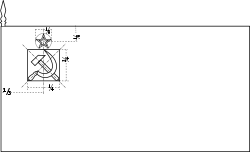
(c) I, Cmapm, CC BY-SA 3.0
The flag of the Soviet Union (1955-1991) using a darker shade of red.

Flag of Iran. The tricolor flag was introduced in 1906, but after the Islamic Revolution of 1979 the Arabic words 'Allahu akbar' ('God is great'), written in the Kufic script of the Qur'an and repeated 22 times, were added to the red and green strips where they border the white central strip and in the middle is the emblem of Iran (which is a stylized Persian alphabet of the Arabic word Allah ("God")).
The official ISIRI standard (translation at FotW) gives two slightly different methods of construction for the flag: a compass-and-straightedge construction used for File:Flag of Iran (official).svg, and a "simplified" construction sheet with rational numbers used for this file.
Olympijská vlajka
Flag of Canada introduced in 1965, using Pantone colors. This design replaced the Canadian Red Ensign design.
Georgian flag in Pantone MS.
Alireza_Dabir.
Flag of Hungary, from 6 November 1915 to 29 November 1918 and from August 1919 until mid/late 1946.



